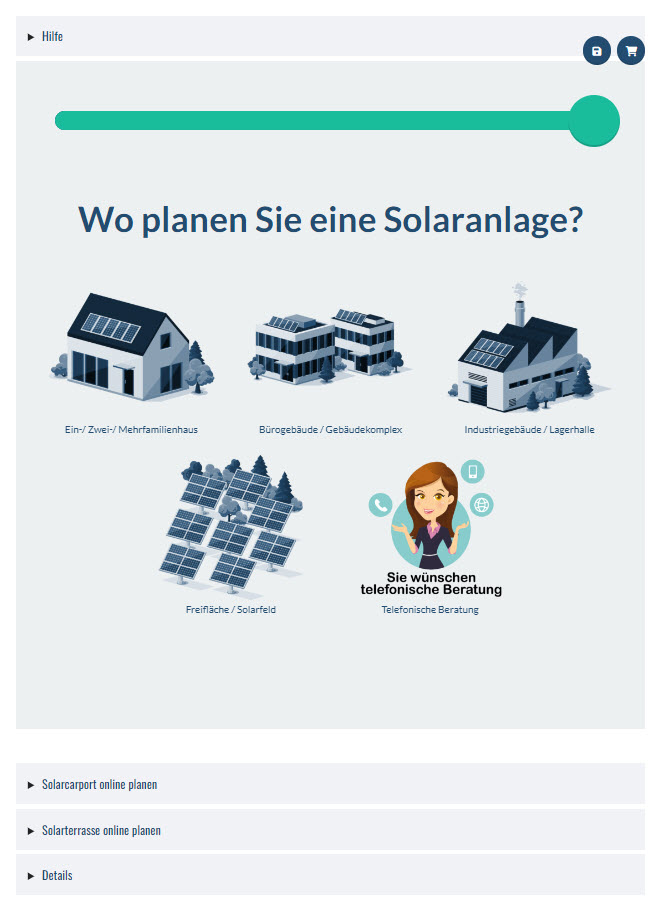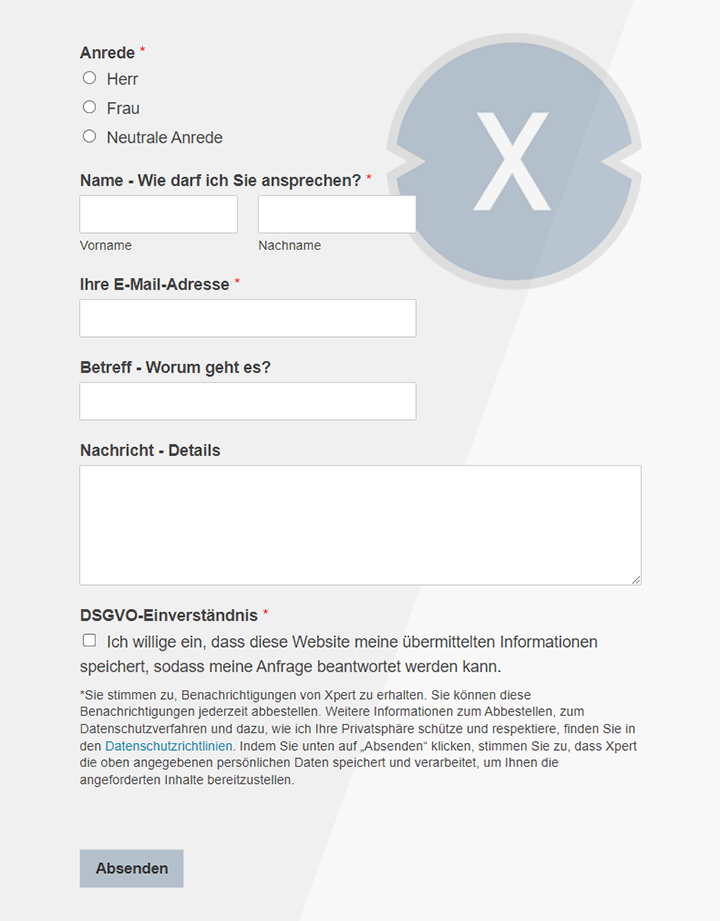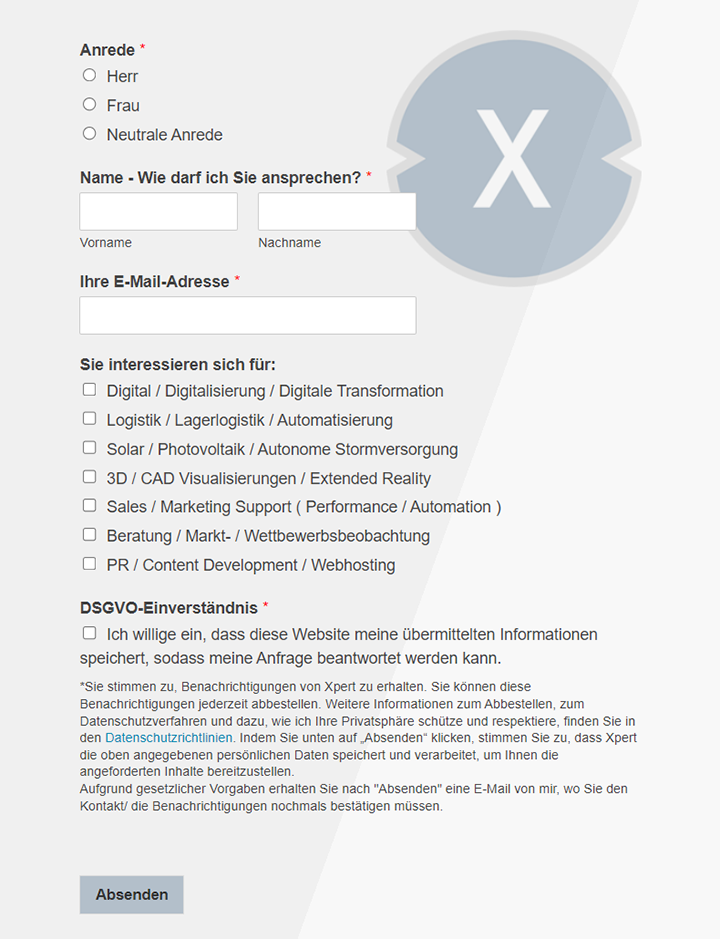There is talk of deception and dizziness: the new Solarspitzen Act 2025 - Come on the feed -in tariff
Xpert pre-release
Language selection 📢
Published on: March 10, 2025 / update from: March 10, 2025 - Author: Konrad Wolfenstein

There is talk of deception and dizziness: the new Solarspitzengesetz 2025 - no loss of feed -in tariff - Image: Xpert.digital
Changes for PV operators: The new Solarspitzen Act 2025 at a glance
The new solar tip law 2025: Effects for photovoltaic system operators in Germany
On February 25, 2025, the so -called “Solarspitzen Act” came into force in Germany, which brings significant changes for operators of photovoltaic systems. This law, with a complete name "Law on the Change of Energy Industry Law to avoid temporary generation surpluses", aims to improve the network stability and regulate overproduction. For operators of new PV systems, this means adaptation to new remuneration structures and technical requirements. The effects are greater than many-analyzes show that conventional PV systems, which are laid out to feed, could suffer about 21 percent of remuneration losses on average due to the new regulations.
The great illusion - political deception - the wrong promise of solar energy - the dark side of solar funding - the end of the solar rooms?
Suitable for:
- PV/Solar: Photovoltaic system 2.0 – An economical solution with battery storage, dynamic electricity tariffs and intelligent control
Central innovations of the Solarspitzen Act
Completion of the feed -in tariff with negative electricity prices
One of the most drastic changes is the elimination of the feed -in tariff in times of negative stock exchange current prices. New PV systems that are put into operation after February 25, 2025 will no longer receive remuneration if there are negative prices on the electricity exchange. Negative prices arise when the supply of electricity exceeds demand-a phenomenon that occurs particularly on sunny days when numerous PV systems produce at the same time. According to forecasts, there were about 457 hours with negative electricity prices in 2024, which corresponds to around 5.2 percent of the year. This regulation is intended to motivate plant operators to use or store their electricity themselves in such times instead of feeding it into the network.
It is noteworthy that the hours are not completely lost without remuneration. The amendment to the law provides that these times are attached to the end of the regular 20-year funding period. This means that plant operators can make up for the lost remuneration hours at a later date, which partially compensates for the financial losses.
For the time being, smaller systems with an installed output under 2 kWP and systems between 2 and 100 kWp are excluded from this regulation, provided no smart meter is installed. This transitional arrangement creates a certain breathing pause in adaptation to the new provisions in particular.
Performance limit and obligation to intelligent measuring systems
Another important innovation concerns the service limit for lack of control technology. Solar systems that go online from February 25, 2025 may initially only feed 60 percent of their individual nominal output, as long as no tax box is installed. This limitation is intended to prevent network overloads from uncontrolled feed -in tips that can occur particularly on sunny days.
The limitation is automatically absent as soon as an intelligent measuring system (smart meter) is installed in combination with a control box. This technology enables more precise control of the feed -in and helps to reduce network bottlenecks. It is important to know that the installation of this technology is not the responsibility of the plant operators, but is responsible for the measuring point operators. Although this relieves the operators from the technical implementation, this can lead to delays if the responsible measuring point operators do not comply with the expansion.
New possibilities for direct marketing and network control
The Solarspitzen Act not only offers challenges, but also new opportunities. It promotes direct marketing of solar power and creates more flexibility on the market. PV system operators can sell their electricity in a targeted manner on the stock exchange, although the obligation to market direct marketing is eliminated and it remains voluntary. This opens up new business models in perspective, in which plant operators can benefit from price fluctuations.
At the same time, the network operator receives more control options. In the event of impending network overloads or blackout hazards, the law authorizes the network operators to regret PV systems in the affected area. This serves the network stability, but also means potential restrictions for the system operators.
Another important change is the introduction of the 15-minute interval for electricity contracts on the day-ahead market. This finer temporal resolution enables a more precise adaptation to the market situation and can lead to optimized feed -in with intelligent control systems.
Suitable for:
- Smart meter, smart money: The market premium model with the PV direct marketing simply explained (for clever homeowners)
Economic effects for plant operators
Losses in conventional system concepts
The economic consequences of the Solarspitzen Act for PV system operators should not be underestimated. Analyzes show that conventional PV systems, which are laid out to feed, could suffer losses of around 21 percent on average due to the cap and stopping of remuneration during negative price periods. This number is based on the examination of real consumption and single-feed data from 2024, including precise load data every 15 minutes and negative electricity hours.
Inspections are particularly affected that are primarily geared towards feeding into the public network and have no or only low storage capacity. For these systems, the temporarily zero remuneration means direct financial losses, even if these hours can theoretically be made up for at the end of the funding period.
The performance limit of 60 percent can also lead to earnings loss if no alternative use is found for the non -fed -out electricity. This can have a noticeable effects, especially on particularly productive sunny days, if the system produces near its maximum performance.
Opportunities through self -consumption optimization and storage solutions
Despite the potential losses, the new law also offers opportunities for optimizing plant operation. By eliminating the feed -in tariff with negative electricity prices, the self -consumption or the storage of the self -produced electricity becomes more attractive. In combination with a power memory, even the 60 percent limitation of power generally does not lead to a loss in the overall yield.
The new law has become even more valuable by the new law, since they can move the feed into the network from midday to a later date. They make it possible to store the solar power when there are negative prices and either use it yourself at a later point in time or to feed it at positive prices.
In the future, intelligent control systems such as “Heartbeat AI” can help to feed electricity automatically and specifically in lucrative time windows. These systems analyze consumption patterns and market prices and optimize the feed -in accordingly. Such an intelligent control can mitigate the negative effects of the Solarspitzen Act and possibly even be converted into an economic advantage.
Suitable for:
Affected systems and transitional regulations
Scope of the law
An important aspect of the Solarspitzen Act is its scope for time. The law applies exclusively to new facilities that are put into operation after February 25, 2025. Investment systems are not affected by the new regulations, which means that the previous remuneration regulations and technical requirements continue to apply to them.
This clear time demarcation creates legal certainty for existing systems and its operators. You do not have to retrofit your systems or expect financial losses. At the same time, however, this leads to unequal treatment between old and new facilities, which could lead to market distortions.
Exceptions and special regulations
The law contains some important exceptions and special regulations. Small systems with an installed output below 2 kWp are excluded from the zero remuneration for negative electricity prices. This primarily affects so -called balcony power plants or small plug -in solar systems, which are primarily designed for self -consumption.
There is also a transitional arrangement for systems between 2 and 100 kWp: they are excluded from the zero remuneration, as long as no smart meter is installed. This regulation takes into account the fact that the expansion of intelligent measuring systems in Germany has so far been slow and not all systems can be immediately equipped with the necessary technology.
Backgrounds and goals of the Solarspitzen Act
Challenges from the PV expansion
The Solarspitzen Act is a reaction to the challenges associated with the rapid expansion of photovoltaics in Germany. In 2024, the proportion of photovoltaics in net electricity generation in Germany was almost 15 percent. This proportion will continue to increase in the coming years, which could lead to problems without corresponding regulations.
The central challenge is that PV systems usually produce with a high simultaneity. On sunny days, more electricity is often produced than the customers ask what can lead to an overload of the public power grids. These surpluses on the electricity exchange lead to negative prices, which means that producers have to pay in fact to get rid of their electricity.
So far, PV system operators have received a guaranteed feed-in tariff, regardless of the market situation. This led to the fact that the problem of network overload was further fed up with negative prices. The Solarspitzen Act should break through this mechanism.
Integration of renewable energies into the electricity market
The overarching goal of the Solarspitzen Act is to improve the integration of solar power into the network and reduce network bottlenecks. It creates incentives for a network and market-related operation of renewable energy systems and promotes the flexibility of the electricity market.
Instead of the unblocked feed -in, the law is intended to encourage or consume self -produced electricity. Specifically, this means that system operators are motivated to feed their electricity when it is actually needed and to save it or to consume it themselves if there is an oversupply.
By accelerating the installation of intelligent measuring systems, the law also contributes to the digitization of the energy transition. Smart meters are an important prerequisite for intelligent control of the power grid and make it possible to flexibly adapt the feed -in to the current network load.
Photovoltaic 2.0: Why memory and smart control are now decisive
The Solarspitzen Act represents a significant turning point for the photovoltaic industry in Germany. It brings substantial changes for operators of new PV systems that offer both challenges and opportunities. The zero remuneration for negative electricity prices and the power limit without smart meters can lead to financial losses. At the same time, the law also creates incentives for a mesh feeding and promotes innovative solutions such as storage systems and intelligent controls.
For potential investors in new PV systems, the law means that you should rethink your system concepts and rely more on your own consumption and flexibility. A conventional system without memory, which is designed purely to feed -in, will be significantly less profitable under the new framework conditions. Instead, combined systems with storage and intelligent control will gain importance.
In the long term, the solar tip law helps to improve the integration of renewable energies into the electricity system and increase network stability. It is an important step on the way to a more flexible, digitized energy system that has grown the challenges of the energy transition. Despite the short -term negative effects on some plant operators, it could prove to be a necessary and sensible measure in the long term in order to make the further expansion of photovoltaics sustainable.
There is talk of deception and dizziness: the new Solarspitzen Act 2025 - Come on the feed -in tariff
The new solar tip law 2025: Effects for photovoltaic system operators in Germany
On February 25, 2025, the so -called “Solarspitzen Act” came into force in Germany, which brings significant changes for operators of photovoltaic systems. This law, with a complete name "Law on the Change of Energy Industry Law to avoid temporary generation surpluses", aims to improve the network stability and regulate overproduction. For operators of new PV systems, this means adaptation to new remuneration structures and technical requirements. The effects are greater than many-analyzes show that conventional PV systems, which are laid out to feed, could suffer about 21 percent of remuneration losses on average due to the new regulations.
Plan your solar system for the most common applications conveniently online with our solar system planner!
With our user-friendly solar system planner you can plan your individual solar system online. Whether you need a solar system for your home, your business or for agricultural purposes, our planner offers you the opportunity to take your specific requirements into account and develop a tailor-made solution.
The planning process is simple and intuitive. You simply enter relevant information. Our planner takes this information into account and creates a tailor-made solar system that meets your needs. You can try out different options and configurations to find the optimal solar system for your application.
Additionally, you can save your plan to review later or share with others. Our customer service team is also available to answer your questions and provide support to ensure your solar system is optimally planned.
Use our solar system planner to plan your individual solar system for the most common applications and advance the transition to clean energy. Start now and take an important step towards sustainability and energy independence!

The solar system planner for the most common applications: Plan the solar system online here - Image: Xpert.Digital
More about it here:
Central innovations of the Solarspitzen Act - background analysis
Come on the Einspeisevergütung negative electricity prices
One of the most drastic changes is the elimination of the feed -in tariff in times of negative stock exchange current prices. New PV systems that are put into operation after February 25, 2025 will no longer receive remuneration if there are negative prices on the electricity exchange. Negative prices arise when the supply of electricity exceeds demand-a phenomenon that occurs particularly on sunny days when numerous PV systems produce at the same time. According to forecasts, there were about 457 hours with negative electricity prices in 2024, which corresponds to around 5.2 percent of the year. This regulation is intended to motivate plant operators to use or store their electricity themselves in such times instead of feeding it into the network.
It is noteworthy that the hours are not completely lost without remuneration. The amendment to the law provides that these times are attached to the end of the regular 20-year funding period. This means that plant operators can make up for the lost remuneration hours at a later date, which partially compensates for the financial losses.
For the time being, smaller systems with an installed output under 2 kWP and systems between 2 and 100 kWp are excluded from this regulation, provided no smart meter is installed. This transitional arrangement creates a certain breathing pause in adaptation to the new provisions in particular.
Performance limit and obligation to intelligent measuring systems
Another important innovation concerns the service limit for lack of control technology. Solar systems that go online from February 25, 2025 may initially only feed 60 percent of their individual nominal output, as long as no tax box is installed. This limitation is intended to prevent network overloads from uncontrolled feed -in tips that can occur particularly on sunny days.
The limitation is automatically absent as soon as an intelligent measuring system (smart meter) is installed in combination with a control box. This technology enables more precise control of the feed -in and helps to reduce network bottlenecks. It is important to know that the installation of this technology is not the responsibility of the plant operators, but is responsible for the measuring point operators. Although this relieves the operators from the technical implementation, this can lead to delays if the responsible measuring point operators do not comply with the expansion.
New possibilities for direct marketing and network control
The Solarspitzen Act not only offers challenges, but also new opportunities. It promotes direct marketing of solar power and creates more flexibility on the market. PV system operators can sell their electricity in a targeted manner on the stock exchange, although the obligation to market direct marketing is eliminated and it remains voluntary. This opens up new business models in perspective, in which plant operators can benefit from price fluctuations.
At the same time, the network operator receives more control options. In the event of impending network overloads or blackout hazards, the law authorizes the network operators to regret PV systems in the affected area. This serves the network stability, but also means potential restrictions for the system operators.
Another important change is the introduction of the 15-minute interval for electricity contracts on the day-ahead market. This finer temporal resolution enables a more precise adaptation to the market situation and can lead to optimized feed -in with intelligent control systems.
Suitable for:
- Forget the feed-in tariff: discover the secret of PV direct marketing (and get it out of the maximum!)
Economic effects for plant operators
Losses in conventional system concepts
The economic consequences of the Solarspitzen Act for PV system operators should not be underestimated. Analyzes show that conventional PV systems, which are laid out to feed, could suffer losses of around 21 percent on average due to the cap and stopping of remuneration during negative price periods. This number is based on the examination of real consumption and single-feed data from 2024, including precise load data every 15 minutes and negative electricity hours.
Inspections are particularly affected that are primarily geared towards feeding into the public network and have no or only low storage capacity. For these systems, the temporarily zero remuneration means direct financial losses, even if these hours can theoretically be made up for at the end of the funding period.
The performance limit of 60 percent can also lead to earnings loss if no alternative use is found for the non -fed -out electricity. This can have a noticeable effects, especially on particularly productive sunny days, if the system produces near its maximum performance.
Opportunities through self -consumption optimization and storage solutions
Despite the potential losses, the new law also offers opportunities for optimizing plant operation. By eliminating the feed -in tariff with negative electricity prices, the self -consumption or the storage of the self -produced electricity becomes more attractive. In combination with a power memory, even the 60 percent limitation of power generally does not lead to a loss in the overall yield.
The new law has become even more valuable by the new law, since they can move the feed into the network from midday to a later date. They make it possible to store the solar power when there are negative prices and either use it yourself at a later point in time or to feed it at positive prices.
In the future, intelligent control systems such as “Heartbeat AI” can help to feed electricity automatically and specifically in lucrative time windows. These systems analyze consumption patterns and market prices and optimize the feed -in accordingly. Such an intelligent control can mitigate the negative effects of the Solarspitzen Act and possibly even be converted into an economic advantage.
Affected systems and transitional regulations
Scope of the law
An important aspect of the Solarspitzen Act is its scope for time. The law applies exclusively to new facilities that are put into operation after February 25, 2025. Investment systems are not affected by the new regulations, which means that the previous remuneration regulations and technical requirements continue to apply to them.
This clear time demarcation creates legal certainty for existing systems and its operators. You do not have to retrofit your systems or expect financial losses. At the same time, however, this leads to unequal treatment between old and new facilities, which could lead to market distortions.
Exceptions and special regulations
The law contains some important exceptions and special regulations. Small systems with an installed output below 2 kWp are excluded from the zero remuneration for negative electricity prices. This primarily affects so -called balcony power plants or small plug -in solar systems, which are primarily designed for self -consumption.
There is also a transitional arrangement for systems between 2 and 100 kWp: they are excluded from the zero remuneration, as long as no smart meter is installed. This regulation takes into account the fact that the expansion of intelligent measuring systems in Germany has so far been slow and not all systems can be immediately equipped with the necessary technology.
Backgrounds and goals of the Solarspitzen Act
Challenges from the PV expansion
The Solarspitzen Act is a reaction to the challenges associated with the rapid expansion of photovoltaics in Germany. In 2024, the proportion of photovoltaics in net electricity generation in Germany was almost 15 percent. This proportion will continue to increase in the coming years, which could lead to problems without corresponding regulations.
The central challenge is that PV systems usually produce with a high simultaneity. On sunny days, more electricity is often produced than the customers ask what can lead to an overload of the public power grids. These surpluses on the electricity exchange lead to negative prices, which means that producers have to pay in fact to get rid of their electricity.
So far, PV system operators have received a guaranteed feed-in tariff, regardless of the market situation. This led to the fact that the problem of network overload was further fed up with negative prices. The Solarspitzen Act should break through this mechanism.
Integration of renewable energies into the electricity market
The overarching goal of the Solarspitzen Act is to improve the integration of solar power into the network and reduce network bottlenecks. It creates incentives for a network and market-related operation of renewable energy systems and promotes the flexibility of the electricity market.
Instead of the unblocked feed -in, the law is intended to encourage or consume self -produced electricity. Specifically, this means that system operators are motivated to feed their electricity when it is actually needed and to save it or to consume it themselves if there is an oversupply.
By accelerating the installation of intelligent measuring systems, the law also contributes to the digitization of the energy transition. Smart meters are an important prerequisite for intelligent control of the power grid and make it possible to flexibly adapt the feed -in to the current network load.
Self-consumption instead of feeding: Why PV operators have to change their strategies
The Solarspitzen Act represents a significant turning point for the photovoltaic industry in Germany. It brings substantial changes for operators of new PV systems that offer both challenges and opportunities. The zero remuneration for negative electricity prices and the power limit without smart meters can lead to financial losses. At the same time, the law also creates incentives for a mesh feeding and promotes innovative solutions such as storage systems and intelligent controls.
For potential investors in new PV systems, the law means that you should rethink your system concepts and rely more on your own consumption and flexibility. A conventional system without memory, which is designed purely to feed -in, will be significantly less profitable under the new framework conditions. Instead, combined systems with storage and intelligent control will gain importance.
In the long term, the solar tip law helps to improve the integration of renewable energies into the electricity system and increase network stability. It is an important step on the way to a more flexible, digitized energy system that has grown the challenges of the energy transition. Despite the short -term negative effects on some plant operators, it could prove to be a necessary and sensible measure in the long term in order to make the further expansion of photovoltaics sustainable.
The criticism of the new Solarspitzen Act 2025 as "deception and dizziness" is based on several central points:
1. Completion of the feed -in tariff with negative electricity prices
The operator of new photovoltaic systems no longer receive remuneration if the electricity exchange has negative prices. For them, this means direct financial losses in certain times, while network operators and large electricity companies continue to benefit from the low prices. Critics see this a disadvantage of small PV operators in favor of large energy companies.
2. Hidden subsidization of large players
The regulation for the "shift" of the lost remuneration times to the end of the 20-year funding period may appear like compensation at first glance. In fact, it is a delay of payments that is economically disadvantageous. In addition, future changes in the law could continue to make this catch up more difficult.
3. Performance limit without a smart meter
Plants without smart meters are only allowed to feed 60 % of their performance. Although smart meters have to be installed by measuring point operators, there is no guarantee of a timely implementation. This could lead to continuing loss of yield - a disadvantage that is not caused by the plant operators.
4. Forced self -consumption and expensive storage solutions
Due to the lack of feed -in tariff for negative prices, operators are actually forced to invest in memory solutions in order to use their electricity independently. However, memory are expensive and often not attractive economically, especially for smaller operators.
5. Market distortion and unequal treatment
Investments continue to enjoy the old remuneration rules, while new facilities suffer from the restrictive conditions of the law. This leads to an unequal treatment within the industry and can make the construction of PV systems unattractive.
Solar tip law 2025: Does it slow the energy transition?
The Solarspitzen Act 2025 is seen by critics as a hidden measure to throttle small photovoltaic systems and to promote large power companies. While the law is to officially improve network stability, it leads to financial disadvantages for many PV operators in practice and makes it difficult to expand renewable energies.
We are there for you - advice - planning - implementation - project management
☑️ Construction and advice on photovoltaic open-space systems
☑️ Solar park planning ☑️ Agri-photovoltaic implementation
☑️ Solar outdoor systems with dual-use solutions
Xpert.Solar is your ideal partner for the planning, consulting and construction implementation of ground-mounted photovoltaic systems and agricultural photovoltaic projects due to our many years of experience and expertise in the solar energy industry. Xpert.Solar has an experienced team of professionals that offers tailored solutions to farmers and investors. From location analysis to financial and legal advice to technical implementation and monitoring, Xpert.Solar supports its customers professionally and reliably to ensure successful and sustainable implementation.
I would be happy to serve as your personal advisor.
You can contact me by filling out the contact form below or simply call me on +49 89 89 674 804 (Munich) .
I'm looking forward to our joint project.
Xpert.Digital - Konrad Wolfenstein
Xpert.Digital is a hub for industry with a focus on digitalization, mechanical engineering, logistics/intralogistics and photovoltaics.
With our 360° business development solution, we support well-known companies from new business to after sales.
Market intelligence, smarketing, marketing automation, content development, PR, mail campaigns, personalized social media and lead nurturing are part of our digital tools.
You can find out more at: www.xpert.digital - www.xpert.solar - www.xpert.plus



























